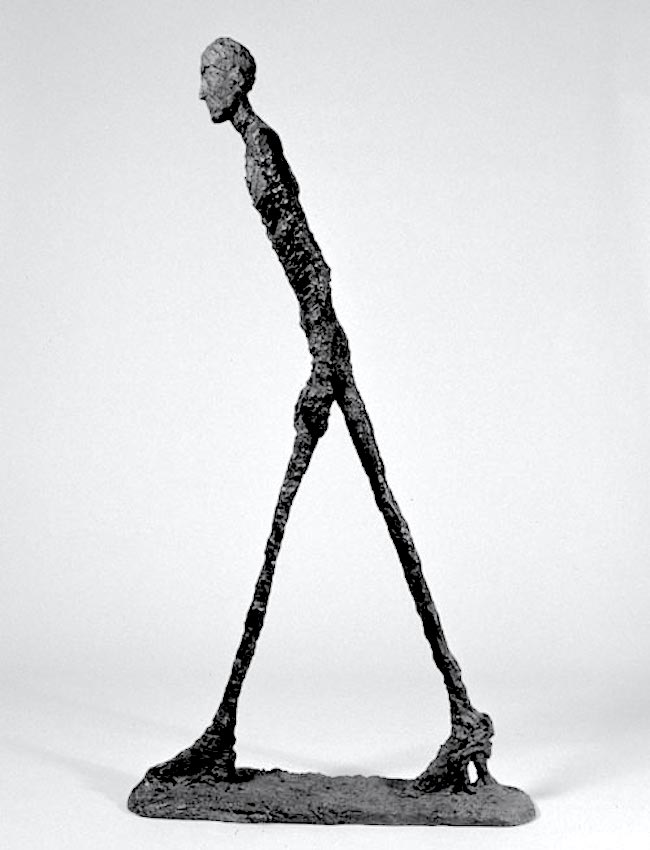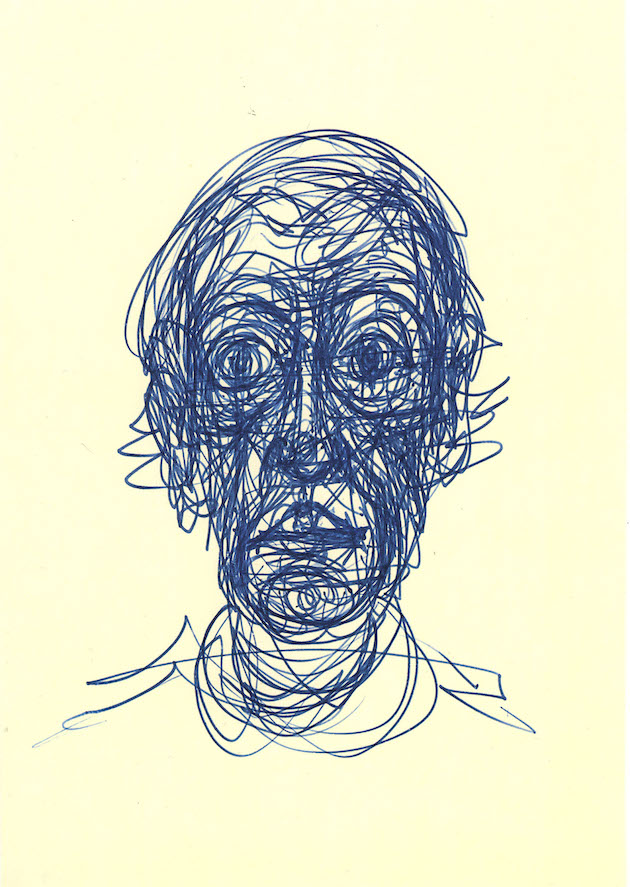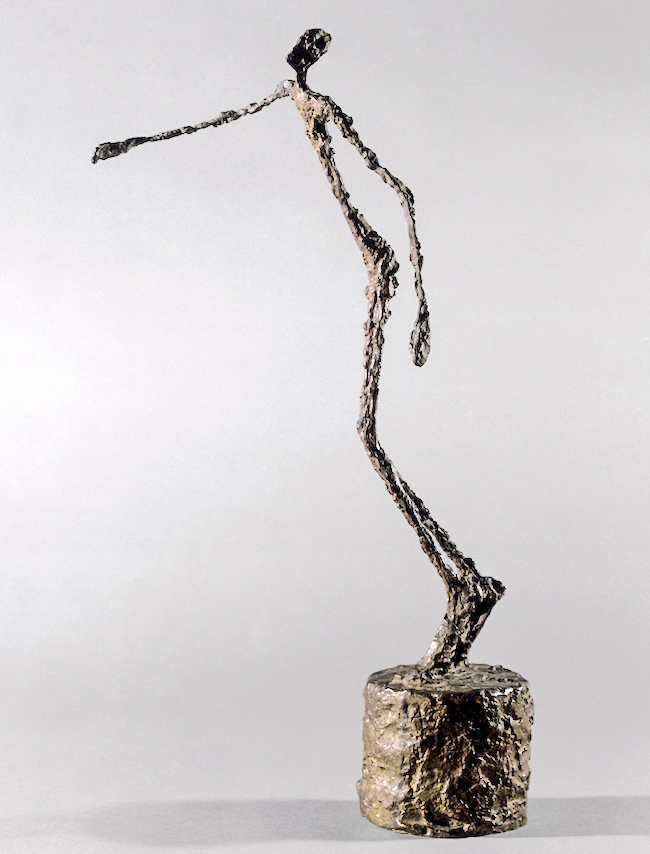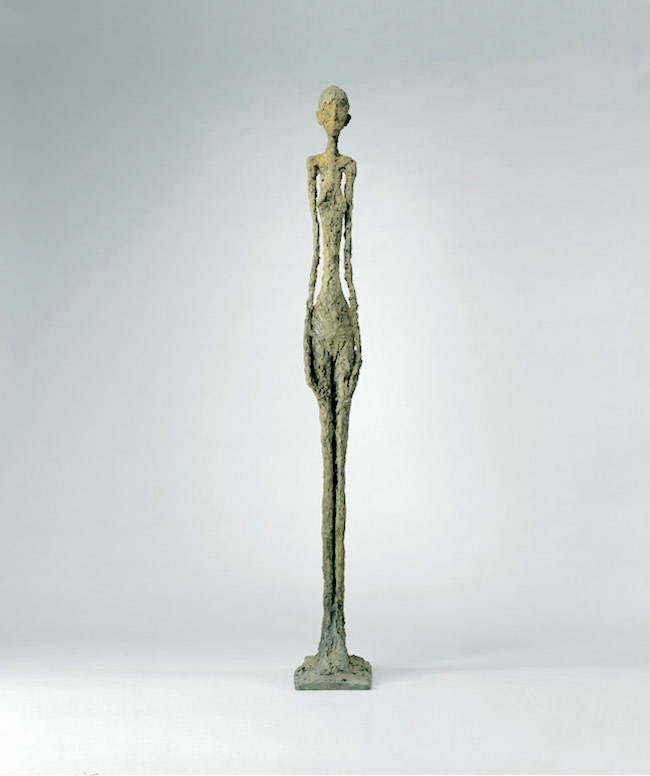
I remember when I saw my first Giacometti statue. It was in the Foundation Maeght, near St Paul de Vence, in Provence. The gallery was founded by two local art dealers, Marguerite and Aimé Maeght, who were friends with many of great figures of modernism. The Foundation Maeght houses one of the great collection of twentieth century art – Chagall, Braque, Bonnard, Miro, Leger, Kandinsky, Hepworth, Hartung, Soulages, Takes, Kelly, Lam… And outside stands the Giacometti courtyard, a gloriously rich collection of some of the sculptor’s greatest works.
What struck me in seeing the first Giacomettis in the flesh, was the way in which they were simultaneously both visceral and abstract. A Giacometti figure conveys both an intangible sense of our humanness and yet also a brute, sensual imagining of how we exist as humans.
The stupendous current exhibition at the Tate Modern in London equally conveys that sense of Giacometti, both as abstract and as visceral. The exhibition consists not simply of Giacometti’s sculptures, but also his drawings and paintings, which are worth seeing in themselves. My favourite room is probably Room 2, which shows his early works from the 1920s, and of his transition from naturalistic to more abstract forms. You get the sense here of an artist battling with himself to find a form to express his vision. Much of the work feels almost private, not really for public showing. ‘I am very interested in art but I am instinctively more interested in truth’, he wrote. You can glimpse in the Tate exhibition Giacometti’s struggle with himself to discover what that truth may be.
A few years after I saw my first Giacometti, I read Jean Paul Sartre’s essay on the sculptor ‘The Quest for the Absolute’. The two men were friends, and Giacometti came to to see himself as standing in the existential tradition, and of his work as asking existential questions about humanness, and human fragility, in the post-Holocaust world.
First published for a Giacometti exhibition in New York in 1948, Sartre’s essay sees Giacometti’s figures as intertwined with the space between and around them, and as revealing the importance of the subjective gaze. Sartre tries to show what makes Giacometti’s work so different from classical sculpture, and of how it tries to transform the way in which we look upon other human beings. It is, like much of Sartre’s writing, both insightful and wordy, both illuminating and obscure. It gives a sense of what I felt, and still feel, of Giacometti’s figures as both visceral and abstract. I am publishing here edited extracts from Sartre’s essay (taken largely from We Have Only This Life to Live: The Selected Essays of Jean-Paul Sartre, 1939-1975, ed Ronald Aronson and Adrian Van Den Hoven [New York Review Books]) . And if you get the chance, do see the exhibition at the Tate Modern , or, better still, the Giacometti courtyard at the Foundation Maeght.

Jean-Paul Sartre
The Quest for the Absolute: On Giacometti’s Sculpture
I know no one else so sensitive as he is to the magic of faces and gestures. He views them with a passionate desire, as though he were from some other realm. But at times, tiring of the struggle, he has sought to mineralize his fellow human beings: he saw crowds advancing blindly toward him, rolling down the avenues like rocks in an avalanche. So each of his obsessions remained a piece of work, an experiment, a way of experiencing space.
‘He’s quite mad’, you will say. ‘Sculptors have been working away for three thousand years – and doing it very well – without such fuss. Why doesn’t he apply himself to producing faultless works by tried-and-tested techniques, instead of feigning ignorance of his predecessors?’
The fact is that for three thousand years sculptors have been carving only corpses. Sometimes they are called reclining figures and are placed on tombs; sometimes they are seated on curule chairs or perched on horses. But a dead man on a dead horse does not amount to even half a living creature. The rigid people found in museums, these white-eyed figures are deceiving us. The arms pretend to move but are held up by iron rods; the frozen forms struggle to contain an infinite dispersion within themselves. It is the imagination of the spectator, foołed by a crude resemblance, that lends movement, warmth, and life here to the eternal deadweight of matter.
So we must start again from scratch. After three thousand years the task of Giacometti and contemporary sculptors is not to add new works to the galleries but to prove that sculpture is possible. To prove it by sculpting the way Diogenes, by walking, proved there was movement. To prove it, as Diogenes did against the arguments of Parmenides and Zeno. It is necessary to push to the limits and see what can be done…

Giacometti himself is forever beginning anew… ‘If I only knew how to make one’, says Giacometti, ‘I could make thousands.’ While the problem remains unsolved, there are no statues at all, but just rough hewings that interest Giacometti only insofar as they bring him closer to his goal. He smashes everything and begins again. From time to time, his friends manage to rescue a head, a young woman, or an adolescent from the massacre. He leaves them to it and goes back to his work. In fifteen years he has not held a single exhibition. He allowed himself to be talked into this one because he has to make a living, but he remains troubled by it. Excusing himself, he wrote: ‘It is, above all, because I was goaded by the terror of poverty that these sculptures exist in this state(in bronze and photographed), but I am not quite sure of them. All the same they were more or less what I wanted. Barely.’
What bothers him is that these moving approximations, still halfway between nothingness and being, still in the process of modification, improvement, destruction, and renewal, assumed an independent, definitive existence and embarked on a social career far beyond his control. He is gong to forget them. The marvelous unity of this life of his intransigence in his quest for the absolute…
He has chosen for himself a weightless material, the most ductile, the most perishable, the most spiritual: plaster. He can barely feel it beneath his fingertips; it is the intangible counterpart of his movements.
What one notices first in his studio are strange scarecrows made of white blobs, coagulating around long russet strings. His adventures, ideas, desires, and dreams are projected for a moment onto his little paster men; they give them form and pass on, and form passes with them. Each of these perpetually changing agglomerations seems to be Giacometti’s very life transcribed into another language.

Classical statues insolently fling their heavy eternity in our faces. But the eternity of stone is synonymous with inertia; it is a present that is fixed forever. Giacometti never speaks of eternity, never thinks of it. He said a fine thing to me one day about some statues he had just destroyed: ‘I was happy with them, but hey were made to last only a few hours.’ A few hours: like a dawn, a momentary sadness, or a mayfly. And it is true that his figures, being designed to perish on the very night of their birth, are the only sculptures I know that retain the extraordinary but apparently perishable grace. Never was material less eternal, more fragile, more nearly human. Giacometti’s material, this strange flour with which his studio is powdered, beneath which it is buried, slips under his nails and into the deep wrinkles of his face; it is the dust of space…
Giacometti has a horror of the infinite. Not the Pascalian infinite, the infinitely large. There is another more insidious, secret infinite that runs through his fingers: the infinite of divisibility. ‘In space’, says Giacometti, ‘there is too much’. This ‘too much‘ is the pure and simple coexistence of juxtaposed elements. Most sculptors have fallen into the trap; they have confused the profligacy of extension with generosity; they have put too much into their works; they have delighted in the plump contour of a marble haunch; they have spread human gesture out, fleshed it out, bloated it.
Giacometti knows there is no excess in a living person, because everything is function. He knows space is a cancer of being that gnaws at everything. For him, to sculpt is to trim the fat from space, to compress it so as to wring all externality from it. The attempt may appear hopeless, and on two or three occasions Giacometti has, I believe, been on the verge of despair. If sculpting means cutting up and stitching together again within this incompressible milieu, then sculpture is impossible. ‘And yet’, he said, ‘if I begin my statue the way they do, at the tip of the nose, it will take me more than an infinity of time to reach the nostril’. That was when he made his discovery.

Take Ganymede on his pedestal. Ask how far he is from me and I will say I don’t know what you are talking about. By ‘Ganymede’ do you mean the youth carried off by Jupiter’s eagle? If so, I’ll say there’s no real relationship of distance between us, for the very good reason that he does not exist. Or are you referring to the block of marble the sculptor has fashioned in the image of the handsome youth? If so, we are dealing with something real, with an existing block of mineral, and we can take measurements.
Painters have long understood all this, because, in paintings, the unreality of the third dimension necessarily entails the unreality of the other two. So the distance from the figures to my eyes is imaginary. If I step forward, I move nearer not to them but to the canvas…
Sculptors did not recognize these elementary truths because they were working in three-dimensional space on a real block of marble, and though the product of their art was an imaginary man, they thought it possible to project him in a real space. This confusion of two spaces has had some odd results. First, when they were sculpting from nature, instead of reproducing what they saw – that is to say, a model ten paces away – they shaped in clay that which was or, in other words, the model in itself. Since they wanted the statue to reproduce for the spectator ten paces away the impression the model had given them, it seemed logical to make a figure that would be for the spectator what the model had been for them. And that was possible only if the marble was here in the same way as the model had been over there.

But what does it mean to be here and over there? Ten paces from her, I form a certain image of this female nude; if I approach and look at her from close up, I no longer recognize her; the craters, crevices, cracks, the rough, black tufts, the greasy streaks, all this lunar orthography simply cannot be the smooth fresh skin I was admiring from afar. Is this what the sculptor should imitate? But his task would be endless and, besides, no matter how close he came to her face, it would be possible to get closer.
It follows that the statue will never truly resemble what the model is or what the sculptor sees. It will be constructed according to certain somewhat contradictory conventions, with some details that are not visible from so far away being shown, on the pretext that they exist, and certain others that exist just as much not being shown, on the pretext that one cannot see them…
The consequences are that the properties of real space cover up and mask those of imaginary space: more especially, the real divisibility of the marble destroys the indivisibility of the figure. It is the stone which triumphs, as does Zeno. The classical sculptor slides into dogmatism, believing that he can eliminate his own gaze, and sculpt human nature in general; but he does not know what he is making because he does not make what he sees. In seeking the truth, he has found only convention. And as, in the end, he shifts responsibility for breathing life into these inert simulacra onto the visitor, the classical seeker of the absolute ends by having his work depend on the relativity of the viewpoints from which it is seen. As to the spectator, he takes the imaginary for the real and the real for the imaginary…

With a classical statue, one must study it or approach it; each moment one grasps new details. The parts appear separately, then parts of the parts and one ends up by getting lost. You do not approach a Giacometti sculpture. Do not expect this bosom to flesh out as you draw near; it will not change and, as you move toward it, you will have the strange impression of walking on the spot. As for the tips of these breasts, we sense them, divine them, are almost able to see them: one more step, two, and we are still sensing them; another step and everything vanishes. All that remains are creases in the plaster. These statues can only be viewed from a respectful distance. Yet everything is there: the whiteness and roundness, the elastic saggings of a well-developed breast. Everything except the substance. At twenty paces we feel we feel we can see the wearisome wasteland of adipose tissue. But we cannot: it is suggested, outlined, signified, but not given…
What must be understood is that is that these figures, who are wholly and all at once what they are, do not allow one to study them. As soon as I see them, I know them. They burst into visual field like an idea in my mind. The idea alone possesses such immediate translucency, the idea alone is at a stroke what it is… It is to give sensible expression to this pure presence, to this gift of the self, to this instantaneous coming forth, that Giacometti resorts to elongation.
The original movement of creation – that timeless, indivisible movement so beautifully figured in the long, gracile limbs – runs through these Greco-like bodies, and lifts them heavenward. I recognize in them, more clearly than in an athlete of Praxiteles, the figure of Man, the real beginning and absolute source of gesture. Giacometti has been able to give this matter the only truly human unity – the unity of action.

Such, I believe, is the sort of Copernican revolution Giacometti has tried to introduce into sculpture. Before him, artists thought they were sculpting being, and that absolute dissolved into an infinity of appearances. He has chosen to sculpt the situated appearance, and he has shown that in this way the absolute may be attained. He shows us men and women already seen. But not already seen by him alone. These figures are already seen as the foreign language we try to learn is already spoken. Each one of them reveals human being as one sees him to be, as he is for other human beings, as he appears in an intersubjective world – not for the sake of simplification at ten or twenty paces, but at a human distance from us. Each imparts to us the truth that a human being is not there first and to be seen afterwards, but that he is the being whose essence it is to exist for others. When I look at this woman of plaster, it is my cool gaze I encounter in her. Hence the delightful disquiet which the sight of her occasions. I feel compelled and I do not know to what end or by whom until I discover that I am compelled to see, and compelled by myself.
The images are all of Giacometti works. From the top down: Walking Man 1; Head of a man on a rod; Drawing of Diego; Head of a man (Lotar 1); Head skull; Falling Man; Standing Woman; Painting of Diego.

Excellent and timely post, if I may be so presumptuous as to say so. Two complaints about the exhibition; many major works were so placed that it was impossible to walk round them (despite Sartre’s comments on immediacy of impact, still an essential part of experiencing a sculpture), and, if the excellent recent BBC documentary is to be believed, the description of his private life and meeting with Annette has been sanitised.